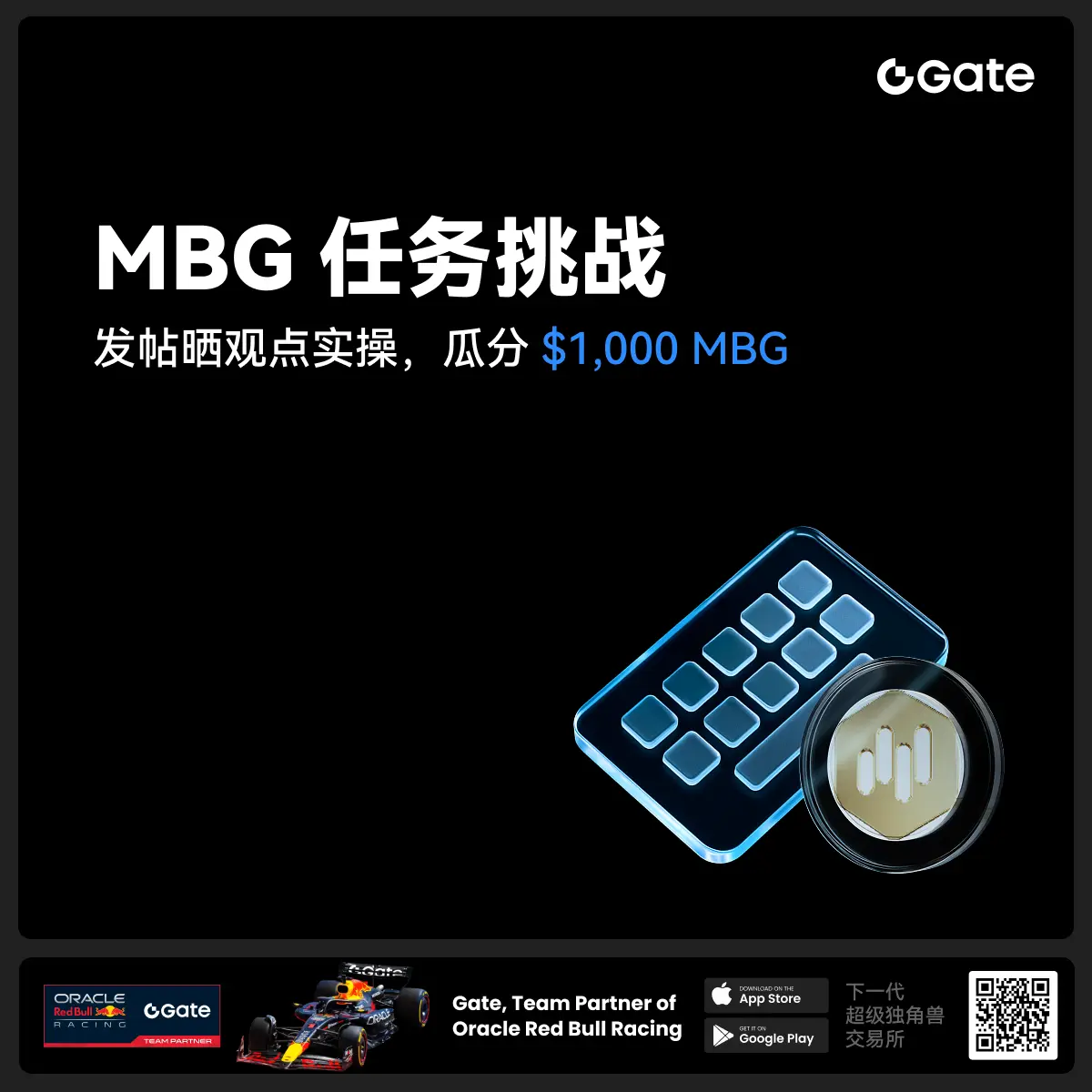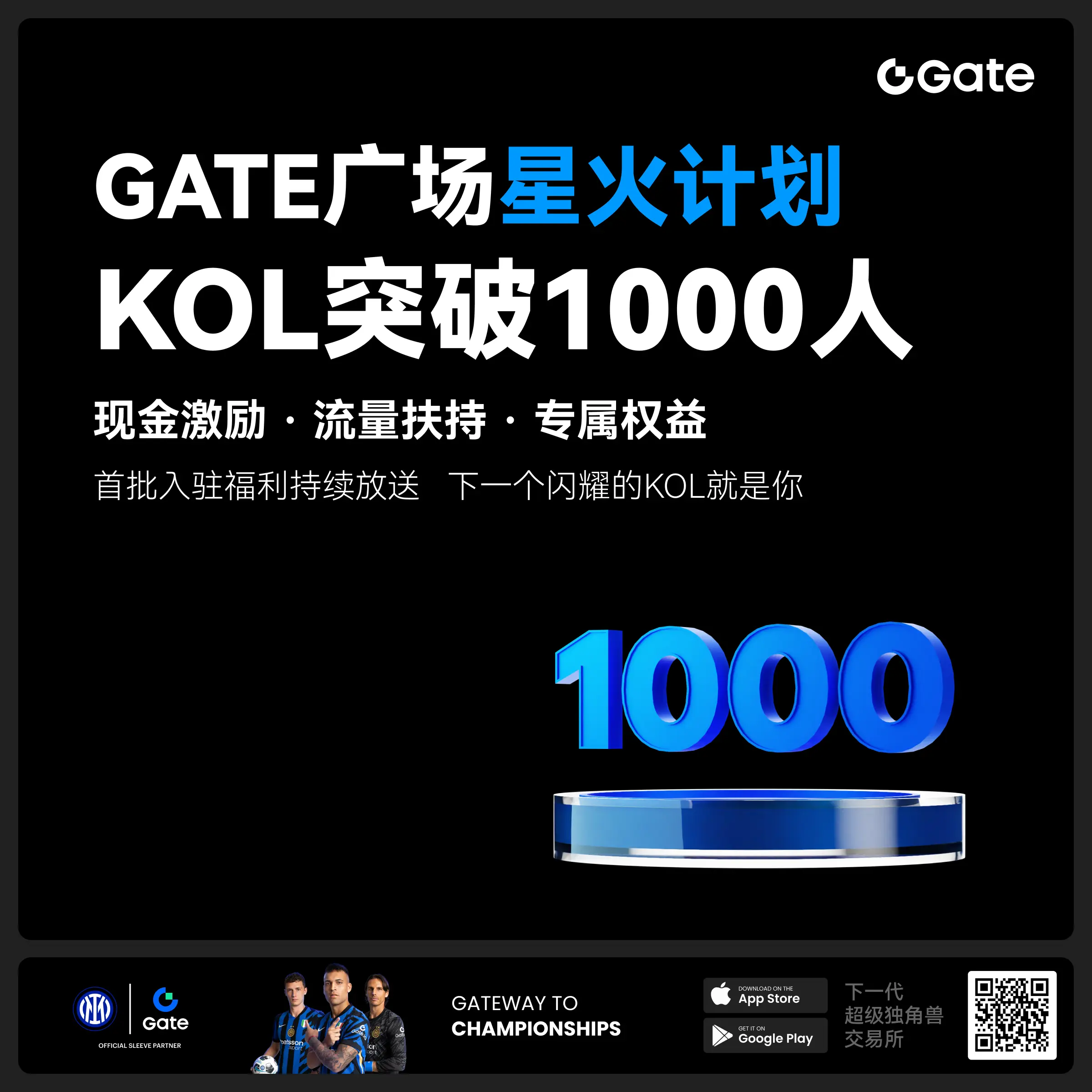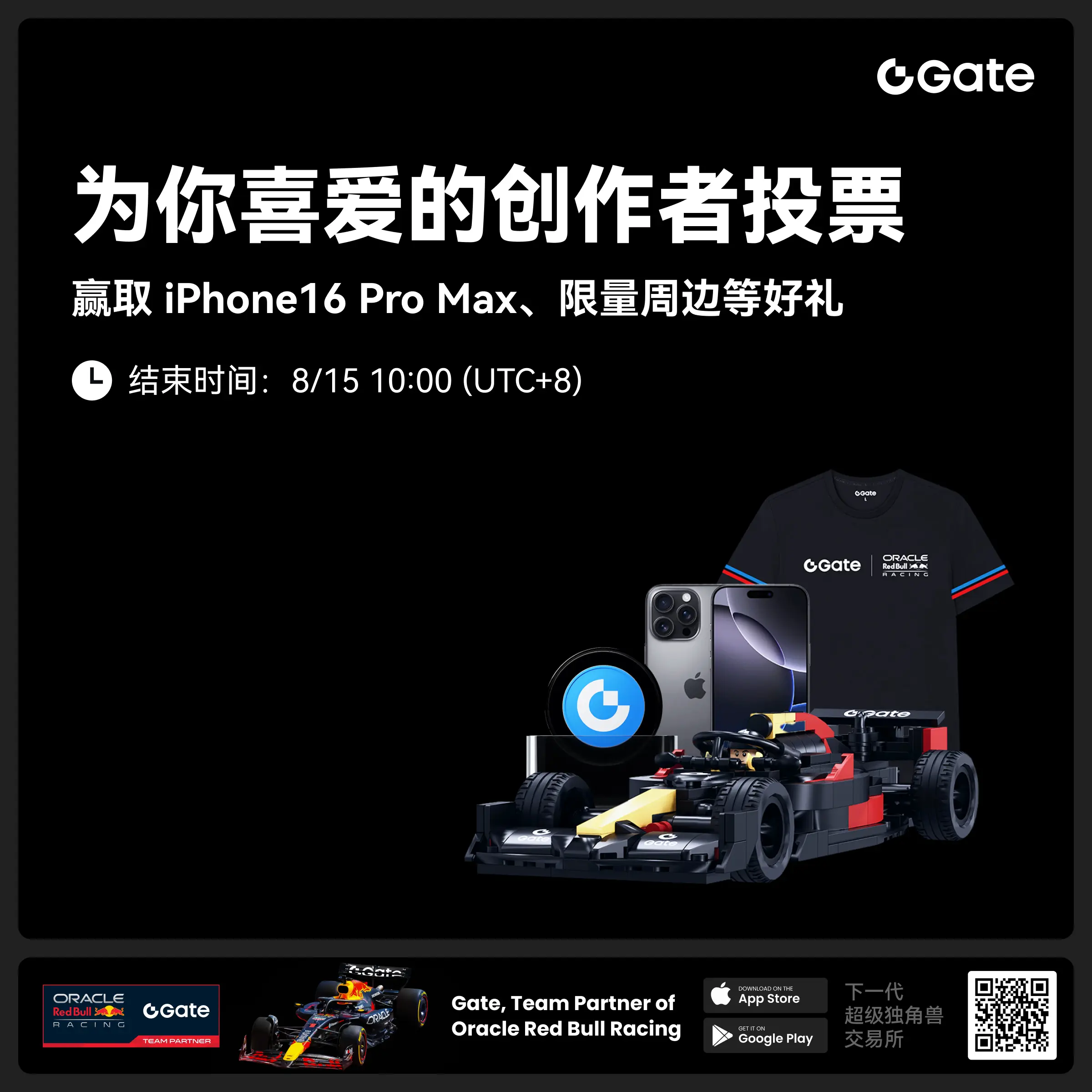- 話題1/3
9008 熱度
19256 熱度
15150 熱度
52757 熱度
22797 熱度
- 置頂
- 📢 Gate廣場 #MBG任务挑战# 發帖贏大獎活動火熱開啓!
想要瓜分1,000枚MBG?現在就來參與,展示你的洞察與實操,成爲MBG推廣達人!
💰️ 本期將評選出20位優質發帖用戶,每人可輕鬆獲得50枚MBG!
如何參與:
1️⃣ 調研MBG項目
對MBG的基本面、社區治理、發展目標、代幣經濟模型等方面進行研究,分享你對項目的深度研究。
2️⃣ 參與並分享真實體驗
參與MBG相關活動(包括CandyDrop、Launchpool或現貨交易),並曬出你的參與截圖、收益圖或實用教程。可以是收益展示、簡明易懂的新手攻略、小竅門,也可以是現貨行情點位分析,內容詳實優先。
3️⃣ 鼓勵帶新互動
如果你的帖子吸引到他人參與活動,或者有好友評論“已參與/已交易”,將大幅提升你的獲獎概率!
MBG熱門活動(帖文需附下列活動連結):
Gate第287期Launchpool:MBG — 質押ETH、MBG即可免費瓜分112,500 MBG,每小時領取獎勵!參與攻略見公告:https://www.gate.com/announcements/article/46230
Gate CandyDrop第55期:CandyDrop x MBG — 通過首次交易、交易MBG、邀請好友註冊交易即可分187,500 MBG!參與攻略見公告:https://www.gate.com/announcements
- 🎉 Gate廣場“星火計劃”入駐KOL突破1000人!
💥 創作者生態迎來全面爆發期!
📈 上首頁、拿獎勵、贏影響力,你還在等什麼?
💰 現金激勵 ✔️
🚀 流量扶持 ✔️
👑 專屬認證 ✔️
從0到1000,我們只用了短短數周,Gate廣場正在成爲Web3內容風暴眼⚡
你發布的不只是內容,而是下一個“爆款機會”!
🌟 加入星火計劃,開啓你的爆發之路!
👉 https://www.gate.com/announcements/article/45695
#GateSquare # #星火计划# #内容创作者新纪元 # #KOL集结令#
- 📢 #Gate广场征文活动第三期# 正式啓動!
🎮 本期聚焦:Yooldo Games (ESPORTS)
✍️ 分享獨特見解 + 參與互動推廣,若同步參與 Gate 第 286 期 Launchpool、CandyDrop 或 Alpha 活動,即可獲得任意獎勵資格!
💡 內容創作 + 空投參與 = 雙重加分,大獎候選人就是你!
💰總獎池:4,464 枚 $ESPORTS
🏆 一等獎(1名):964 枚
🥈 二等獎(5名):每人 400 枚
🥉 三等獎(10名):每人 150 枚
🚀 參與方式:
在 Gate廣場發布不少於 300 字的原創文章
添加標籤: #Gate广场征文活动第三期#
每篇文章需 ≥3 個互動(點讚 / 評論 / 轉發)
發布參與 Launchpool / CandyDrop / Alpha 任一活動的截圖,作爲獲獎資格憑證
同步轉發至 X(推特)可增加獲獎概率,標籤:#GateSquare 👉 https://www.gate.com/questionnaire/6907
🎯 雙倍獎勵機會:參與第 286 期 Launchpool!
質押 BTC 或 ESPORTS,瓜分 803,571 枚 $ESPORTS,每小時發放
時間:7 月 21 日 20:00 – 7 月 25 日 20:00(UTC+8)
🧠 寫作方向建議:
Yooldo
- 🎉Gate 2025 上半年社區盛典:內容達人評選投票火熱進行中 🎉
🏆 誰將成爲前十位 #Gate广场# 內容達人?
投票現已開啓,選出你的心頭好
🎁贏取 iPhone 16 Pro Max、限量週邊等好禮!
📅投票截止:8 月 15 日 10:00(UTC+8)
立即投票: https://www.gate.com/activities/community-vote
活動詳情: https://www.gate.com/announcements/article/45974
- 📢 #Gate广场征文活动第二期# 正式啓動!
分享你對 $ERA 項目的獨特觀點,推廣ERA上線活動, 700 $ERA 等你來贏!
💰 獎勵:
一等獎(1名): 100枚 $ERA
二等獎(5名): 每人 60 枚 $ERA
三等獎(10名): 每人 30 枚 $ERA
👉 參與方式:
1.在 Gate廣場發布你對 ERA 項目的獨到見解貼文
2.在貼文中添加標籤: #Gate广场征文活动第二期# ,貼文字數不低於300字
3.將你的文章或觀點同步到X,加上標籤:Gate Square 和 ERA
4.徵文內容涵蓋但不限於以下創作方向:
ERA 項目亮點:作爲區塊鏈基礎設施公司,ERA 擁有哪些核心優勢?
ERA 代幣經濟模型:如何保障代幣的長期價值及生態可持續發展?
參與並推廣 Gate x Caldera (ERA) 生態周活動。點擊查看活動詳情:https://www.gate.com/announcements/article/46169。
歡迎圍繞上述主題,或從其他獨特視角提出您的見解與建議。
⚠️ 活動要求:
原創內容,至少 300 字, 重復或抄襲內容將被淘汰。
不得使用 #Gate广场征文活动第二期# 和 #ERA# 以外的任何標籤。
每篇文章必須獲得 至少3個互動,否則無法獲得獎勵
鼓勵圖文並茂、深度分析,觀點獨到。
⏰ 活動時間:2025年7月20日 17
Weebly 創始人:如何找到適合產品市場的產品?
演講:David Rusenko,Weebly 創始人
編譯:深潮TechFlow
Weebly 旅程
Weebly 是一種簡單的方式,可以讓創業者建立網站或在線商店。在Weebly 被創建之前,唯一的方法就是學會自己編碼。而現在已經有很多工具和服務可以讓你拖放和建立一個網站了。 Weebly 發展迅速,到2018 年已有5000 萬用戶,並被Square 以3.65 億美元收購。
美國一半的人口每個月都會訪問一個小網站,這反映了企業家們的成功,人們通過自己的網站實際上取得了成功並看到了結果。因此,我認為如何找到適合的產品市場是每個人都要面對的首要問題。
2006 年,我在賓夕法尼亞州的海狸體育場寫了第一行代碼。六個月過去了,我和合夥人仍未推出產品。我在Slashdot 上看到YC,花了兩個小時創建了YC 應用程序,並打電話給合夥人詢問意見。第二天,我們開車去面試,被錄取了。起初,我們只有兩個服務器,擔心服務器會被燒毀。因此決定讓用戶註冊後等待名單,然後聯繫他們。經歷媒體衝擊後,網站的用戶數量下降極低,直到整個網站關閉。
在2007 年1 月,經過11 個月的努力,我和合夥人輟學,將所有服務器裝在車裡,開車去了舊金山。我們租了一套兩居室的公寓,並把三張桌子推到一起全職工作,每天除了周六都工作到累為止。雖然獲得了一些媒體報導,但新用戶數量卻不斷下降,這意味著我們沒有適合的產品市場。
2007 年5 月,我們的銀行賬戶只剩100 美元,租金也在上漲。演示日前一周,我們以200 萬美元估值完成了65 萬美元的A 輪融資。當時被稱為A 輪融資,今天,它可能會被稱為種子期前融資,略高於平均水平。
但是我們的產品在18 個月內人家給就沒有適合的產品市場。在第20 個月時一切都發生了改變,我們開始得到真正的牽引力並吸引了許多用戶。直到2010 年2 月我們才在市場上有了不錯的成績。
產品市場契合度
在創業公司的發展過程中,產品市場適合性的定義非常重要。找到適合的產品市場和建立世界級團隊是創業公司最困難的兩件事情。賺錢和擴展成為一個大而持久的公司也很具有挑戰性。在這個過程中,不要忘記持續精煉和建立適合的產品市場。最好的公司會創造一個新的市場,而找到隱藏需求是其中最困難的部分。市場調查對於創造新市場並不實用,需要找到其他人沒有意識到的需求。
2006 年夏天,我寫完第一行代碼後去了紐約科技會議。在與1000 人交流後,我發現隱藏的需求是很多人想要創建自己的網站,但這很困難。我們意識到這個需求,建立了一種服務,使人們能夠輕鬆創建自己的網站。
重要的是,要了解人們想做什麼工作,然後提供更好的替代方案。
創造新市場時,人們可能會誤以為你只是在應對當前市場需求,因此需要建立卓越的產品。
具體來說,第三步是撰寫市場論文,並理解客戶的需求和問題。然後進行快速原型設計和用戶測試,建立解決方案並測試其有效性。如果成功,則不斷重複該過程。
快速原型設計和用戶測試
與客戶交談、傾聽其需求和問題的重要性,在創造過程中不依賴市場調查,而是通過快速原型設計和用戶測試來驗證假設。建議儘早得到一個功能原型,並面向用戶,不要擔心擴展和貨幣化,而是集中精力確保產品體驗正確。然後期望需要大約10 倍的迭代次數來完善產品。
包括保持低強度燃燒,建立一個能夠迭代快速的團隊,與目標客戶交談並靈活調整對其的看法,不要想得太多,儘早展示產品原型,並通過客戶訪談、UX 測試會話和指標跟踪等工具來改進產品。
其中,UX 測試會話被認為是最重要的事情之一,需要讓別人使用產品或服務,鼓勵他們提供公開誠實的反饋,讓他們執行任務,並且不要給予任何幫助或提示,在測試中收集關於產品體驗的有用信息。建議進行三到五個測試會話。
我認為你只需要進行三次UX 測試就可以發現最關鍵和最重要的用戶體驗錯誤。舉個例子,我們曾經啟動了一個主頁,並試圖將註冊表單字段減少到最少,以降低weebly 註冊的摩擦,因此我們刪除了密碼確認欄。
實際上,郵件確認也不再必需,所以我們只要求電子郵件地址和密碼即可。然而,在關閉情況下,一些人輸入了錯誤的密碼,這導致他們的電子郵件被重置。當有人同時輸入了電子郵件和密碼時,他們將需要創建一個新賬戶,但這並不是什麼大問題。
我們將報名表放在頁面上,並使用100 字號寫著「在這裡註冊」。然而,仍有人在UX 測試中無法找到表單,因為他們假設這只是登錄表單,而不是註冊表單。
這促使我們添加了一個免費字段,只要求名字,這樣我們就能夠有三個字段:電子郵件、密碼和名字。
只有通過反複測試,我們才能發現並解決這些問題,因此我建議您在每個階段都進行反複測試。
何時發布產品?
我认为最小显著产品是合适的,而不是最低可行产品,因为它暗示着你可以推出你所能想到的最烂的产品。
相反,我們應該把重點放在製作一個優秀的產品上,並在它變得比現有產品更好時發布它。
最後,我認為確定優先級的最佳方法是關注能讓你進入下一個里程碑的事情,並且優化學習以解決你目前最大的未知問題。
我認為有三個關鍵指標需要跟踪:
不應該包括哪些指標?
首先是註冊率,我們會重點關注活躍的用戶,因為良好的反複使用和註冊轉化率可以帶來更多活躍的用戶。然而,如果用戶體驗不佳,註冊量就會停滯不前,同時活躍用戶數量也會減少。即使你的註冊人數增長了,如果用戶使用率不高,那麼這個數字可能也會隨之下降。
其次是轉換率,因為在考慮建立SAS 業務時,一開始的轉換率都是很低的,隨著時間的推移,我會關注其他指標。
當你適應產品市場時,你會感受到什麼?
當你的客戶走進你的門時,你會知道自己何時成功了。如果你沒有這種感覺,那麼一切都會變得困難。就像推著一塊巨大的石頭上山,你試圖將客戶推向一個解決方案。他們可能會很善良,不想拒絕你,但他們並沒有真正回來,也沒有真正使用你的產品。然而,當你擁有這種感覺時,整個世界都會朝你的門走去,每個人都想使用你的產品,媒體也會報導此事。因此,如果你沒有感覺到客戶將你拉向某個方向並朝你的門走去,那麼你可能還沒有成功。隨著業務規模的擴大和時間的推移,你會發現自己可能比想像中更聰明,但那是以後的事了。
超越產品契合度
我認為在建立一個成功的初創企業時,需要做三件事:
但是,有時即使你製造出一個市場上運行良好的產品,它仍可能過時,因為你的收費方式可能不適合人們的需求。
所以,在製定商業模式時,也需要注意渠道和模型之間的匹配。
團隊規模
此外,在擴大團隊規模之前,應該保持團隊規模小,以便進行微觀管理,了解所有重要的信息,並做出真正偉大的決策。一旦產品市場契合度達到,就應該積極地擴大規模,建立一個積極而周到的團隊。然而,在任何一年裡,公司規模都不應該超過公司兩倍,否則會導致摩天大廈倒塌。當你找到適合的產品市場時,可以積極地進行縮放。
建立品牌
建立品牌也很重要,但花費太多時間去思考並不值得,特別是在早期階段。
偉大的品牌建立在洞察消費者行為的基礎上,這個洞察可能是一些真相,但尚未被承認。理想情況下,這個洞察與你的產品建立在同一個基礎上。因此,如果能在早期識別出這種洞察力,並將其融入到所有信息和產品中,那麼這將非常強大,並成為品牌的基礎。
舉例來說,Virgin America 在創立初期發現人們選擇航空公司的原因只有四個:時間表、價格、目的地和飛行體驗糟糕。
於是他們決定創建一家提供驚人的飛行體驗但價格略高於其他航空公司的航空公司,所有做法都圍繞著飛行體驗展開,並通過員工培訓、公關活動等多種方式使這些成為了他們的品牌和產品基礎。他們為人們買票創造了一個新的理由,而且非常成功。
重要的是理解這一點,並將其融入到產品中,隨著時間的推移成為品牌的基礎。
動機
我認為是我們當時年輕又愚蠢,但這實際上非常有幫助。
很多人認為企業家必須是敢於冒險的風險承擔者,但我並不認為我所認識的大多數創業者都是風險承擔者,相反,我認為他們是計劃周詳的冒險家。
在我看來,一個企業家的成功需要具備兩個主要素質:
首先,他們必須是樂觀主義者,因此,在別人看到風險的地方,他們看到的是機遇;
其次,他們已經做出了決定,所以,他們只會堅定不移地前進,不輕易放棄。
我認為,這兩個素質通常是兩碼事。你的公司只有在你放棄的時候才會失敗,只要你按照定義繼續工作,它就會繼續存在。
因此,我認為只要有這種決心,即使所有的證據表明該計劃行不通,我也不會盲目地制定策略。但同時,只要保持決心並有信心,相信自己生產的產品是人們所需要的,繼續努力就是關鍵。
垂直化
通常來說,針對利基市場的建議是垂直的。換句話說,我們需要定制化的產品來滿足特定目標群體的需求。
然而,在某些情況下,我們可能會選擇反向行動,不按照這種模式去做。這是因為在我們特定的案例中,垂直市場不夠深,無法支持我們所需的大量投資。
事實上,我們需要的是一個功能齊全的平台,包括博客、電子商務、論壇和CMS 等所有必要的功能。然而,沒有任何一個垂直市場能夠獨立地完全支持這樣一個平台。
一般來說,像Weebly 和Just 網站構建者或電子商務平台,則採用了從垂直市場開始建設的模式。隨著時間的推移,他們將所有必要的功能逐漸地添加到平台中,並最終開始定制垂直市場。
因此,在我們的案例中,我們選擇了與傳統模式背道而馳的方法。儘管定制特定垂直市場通常是個好建議,但在我們的情況下,這並不是最佳方式。
創造市場
當你創造一個市場時,關鍵問題是如何讓人們意識到他們需要一種他們之前不認識的新產品。在我的經驗中,這通常是市場創新的第一步。
在威布爾的前三到四年曆史中,我們主要致力於說服人們相信他們可以輕鬆建立自己的網站。這是很有挑戰性的,因為大多數人都認為除非他們具備編程知識,否則他們無法建立自己的網站。
我們花費了良好的四年時間去研究和告訴人們,確實可以建立自己的網站。最終,越來越多的人嘗試並掌握了這項技能,市場也隨之形成。
比如Uber 和Airbnb 這樣的服務,它們都是市場創造的好例子。剛開始,我對於使用陌生人的車或住宿感到不安,但隨著更多人的嘗試和推薦,它們逐漸成為大眾所接受的服務。
一旦市場成功創建,重點就轉向了產品的擴展和改進。此時問題已經不再是如何說服人們相信產品的必要性,而是如何讓更多的人使用並滿意產品。
所以,市場創新是一個漫長而艱難的過程,但只要成功創建了市場,接下來就是如何推廣和改進產品的問題。
關鍵績效指標
我們沒有對這些指標進行監測和測量,這可能就是我們花費了18 個月才使產品有起色時間的原因。
實際上,這可能只需要更短的時間就可以解決。在考慮簽約時,大多數人都會關注這一點,但這是一個很差的度量標準。
如果我們看看註冊用戶轉化為活躍用戶的情況,我們會發現非常低。此外,在每天和每週的基礎上觀察我們的註冊用戶數量,它們都呈下降趨勢。
因此,大家都認為我們的產品市場適合性不夠好,我們需要繼續迭代,直到我們最終得到我們想要的結果。
產品定價
在開始時,矽谷流行的想法是不應該收費,不應該賺錢。這是因為他們認為一旦你有了收入,你的公司就會變得不那麼有吸引力。當時最好的做法是賣夢想而不賺錢,因為這樣可以使公司的估值更高。因此,從2006 年到2008 年夏天,我們的產品基本上是免費的。
但是隨著時間的推移,我們意識到我們需要開始賺錢了。在2008 年1 月,我們決定推出付費版本,即weebly pro,每月4 美元。當我們在推出之前和朋友交流時,我們對銷售額有很高的期望,但實際情況是我們比最低預期少了10 倍。
雖然結果並不理想,但我們持續增長,並於2009 年1 月實現了正現金流,這使我們能夠繼續運營公司。在公司的其餘歷史中,我們都在不斷地發展和成長。
在確定計算活躍用戶時,應該關注哪些方面?
即使在用戶情緒低落的時候,我認為計算活躍用戶仍然可以使用同樣的方法,並且仍然是一個有價值的度量標準。
關鍵在於確定他們是否成功地使用了你的產品,即使他們不是每天都回來,也可能每六個月回來一次。
因此,在這種情況下,我仍然認為度量標準是有用的,因為它能夠提供一些數據,否則你就會盲目地進行決策。
不連續改進
我認為,在你大幅度跨越時,不連續的改進是有效的。有時候,小的增量改進並不能幫助你實現這一大飛躍。舉個例子,如果你從Palm Treo 開始,那麼你可以嘗試不斷地改進操作系統、應用程序,或者改進鍵盤等等。但是,如果你要創造一個新市場,通常需要邁出一大步,進行不連續的改善。這意味著要快速迭代,找到隱藏的需求,找出人們想要什麼,並構建解決方案。在這個過程中,優化學習非常關鍵。因此,我們需要不斷問自己問題,發現未知領域並尋找答案。
籌資過程
大多數公司在進入牽引階段之前無法籌集資金,只有進入牽引階段後才能籌集到資金。但現實情況可能不同,可能你有一些朋友和家人願意進行早期投資,或者你可以進入像YCombinator 這樣的加速器程序。
然而,大多數公司需要經歷一定的歷史積累,例如創始人之前曾創造成功的產品、在該行業或其他領域有巨大影響力等。
如果你希望在早期獲得牽引力之前不籌資,這可能是一個現實的期望。但如何實現呢?這是一個雞和蛋的問題,每個人都用不同的方法解決問題。目前,許多人通過揮霍公平,將聰明的人聚集在一起,構建他們需要的東西,保持低成本,並儘可能快地構建直到達到目標。
為什麼關注客戶需求比追隨競爭對手更重要?
當你擁有比競爭對手更好的東西時,就要將其推向市場。要創造一個全方位的產品,而不僅僅是一個簡單的功能清單。
如果你只是關注功能,那你永遠也無法取勝,因為你總是會落後於別人。我更傾向於「顧客至上」這個理念,因為如果你一直在盯著競爭對手,那麼你就會一直處於跟隨的位置。
不管他們最近發布了什麼新產品,他們都已經做了三個月了。所以當你推出你的產品並引領市場時,他們就會開始復制你的產品。
我記得有一個南非公司籌集了4000 萬美元,而我們只籌集了65 萬美元。他們完全模仿我們的界面並推出了類似的產品,但事實證明他們做得不怎麼樣。
因此,我們必須著眼於客戶本身,而不是競爭對手。這與產品功能清單無關,因為你的產品應該有獨特的特色或優點。也許是易用性和可用性,也許是某個特定的功能,這些都能幫助你進入一個嶄新的市場。這種特點也可能就是人們所需要的,從而使他們購買你的產品。
因此,你的產品並不一定比其他產品具備更多功能,但你的產品能夠更好地滿足客戶的需求,這才是你要追求的目標。